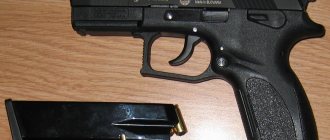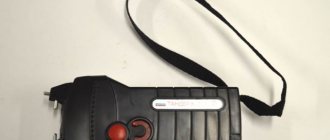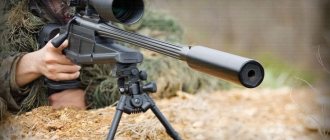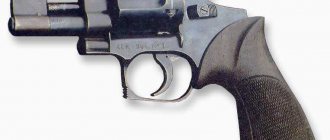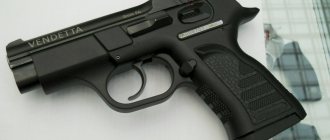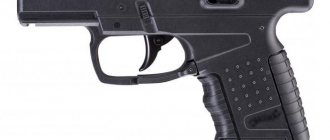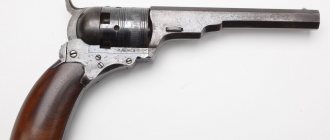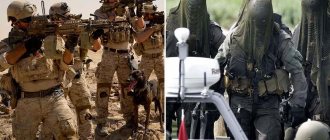Automatic is a rather domestic concept. In foreign qualifications, as a rule, it is an assault rifle or assault carbine , depending on the size. Machine guns also include automatic rifles and submachine guns. The machine gun is capable of creating a high density of fire, which is an ideal individual weapon for defeating enemy personnel in close combat.
We often like to compare how good the Soviet Kalashnikov assault rifle is and how worthless the American M-16 is. But is this really so? In addition to the Russian Federation and the United States, there are other states that have their own weapons, which are no worse. Well, having studied the issue in depth, we present a list of the best of the best assault rifles.
Fifth place - Steyr AUG (Austria)
Army universal rifle, released in 1977. It is one of the oldest automatic rifles among modern analogues.
- Sighting range - 650 meters
- Rate of fire - 750 rounds per minute
- Weight - 3.9 kilograms
- Magazine capacity - 30 rounds
- Initial bullet speed - 922 meters per second
Steyr AUG A3 M1
In addition to its own country, the Austrian rifle is in service in 33 countries , such as Gambia, Luxembourg, Poland, the Philippines, Brazil, Cameroon, Papua New Guinea, including Russia, the USA, and Ukraine.
In Russia it is used mainly in the Airborne Forces, the FSB, the Russian Guard and the Federal Penitentiary Service. Russian troops first used this assault rifle during combat operations in South Ossetia in 2008. Also, the Steyr AUG assault rifle performed well in the Iraq War of 2003-2011.
Assault rifles and machine gunsAustria 5.56 mm AUG "Steyr" family (Stg-77 rifle)
This assault rifle was developed in close cooperation with the Austrian army. The first batches arrived in units in 1978. Mass production is currently ongoing.
The AUG rifle (army universal rifle) can be used in various versions: as an “landing” assault rifle with a barrel length of 350 mm (AUG “Falshirmäger”); like a carbine with a 407 mm barrel; as a standard assault rifle with a barrel length of 508 mm (AUG-A1 or AUG-1); like a light machine gun with a heavy barrel 621 mm long. All models use a magazine with a capacity of 30 rounds, and in the version of the light machine gun - a magazine with a capacity of 42 rounds. All types are equipped with an optical sight, which is made as one piece with a carrying handle. At the customer's discretion, a bracket can be installed for mounting other optical and night sights.
Assault rifle of the AUG-77 family - in the F88 variant
The AUG rifle is designed using a bullpup design and has a modern, streamlined design. Its long barrel, non-standardly positioned sight and powerful chopped butt look unusual. The idea laid down by the developers pursued the goal of creating a modular weapon that was light in weight and easy to handle, which could be used in operations on combat vehicles and the parts of which would make it possible to easily change the configuration of the weapon. So, to shoot from the left shoulder, you need to rearrange the ejector and turn the window cover to eject the cartridges. This simple operation is carried out in the field. The AUG rifle was a first in many respects: the first example of the bullpup design adopted for service, the first modular system, the first production model of an assault rifle with an optical sight as the main one and with extensive use of plastics in the design.
Light weight and simplicity of parts made this rifle popular. The wide butt, which also provides support for the shooter's cheek, makes the stock comfortable for shooters of various builds. In addition to Austria, the AUG-77 was adopted by the armies of Australia, Indonesia, Morocco, New Zealand, Oman, Saudi Arabia, the Irish Defense Forces, and was widely purchased by intelligence services and law enforcement agencies of different countries. The commercial self-loading model is distinguished by the replacement of the standard optical sight with a universal bracket for various models of optical, night and collimator sights, and the impossibility of attaching a bayonet.
For police and special forces in 1987. The 9 mm AUG-9 submachine gun was created. In this case, the magazine socket adapts to the new magazine with a simple plastic insert.
Structurally, the rifle consists of six parts (modules): barrel, receiver, trigger mechanism, bolt, magazine and stock (stock). The barrel is made using the cold forging method developed by Steyr and is chrome plated. An outer coupling, put on while hot, is attached to it, in which a gas hole, a chamber, and a gas regulator are made. The clutch has an articulated arm for the front holding handle. In a short gas chamber there is
a gas piston and an associated return spring are installed. The gas regulator has two positions - the enlarged hole is used when the mechanisms are dirty. A flash suppressor is screwed onto the end of the barrel. The three barrel modifications differ only in size. Eight lugs on the breech of the barrel engage a locking sleeve on the receiver. At the rear, this clutch engages the bolt. The front holding handle is hinged to the gas regulator and can be folded forward (under the barrel), while playing the role of a forend. It is also used to disconnect the barrel when replacing it.
The receiver is made of die-cast aluminum. On the left side there is a slot for the cocking handle, which the shooter operates with his left hand. The carrying handle and sight are made together with the receiver. The front swivel is attached to the front of the scope base.
AUG automation is based on the removal of powder gases from the barrel. Unusual is the displacement of the gas chamber to the right and the installation of a piston on one of the guide rods. The barrel is locked by turning the bolt with seven lugs; instead of the eighth lug, an ejector is installed. The bolt is actuated by the movement of the bolt protrusion along a groove in the bolt frame. The bolt frame has two guide rods with return springs inside; these rods fit into grooves on the receiver. The left rod can be engaged with the cocking handle using a latch, in which case the bolt can be returned to its original position manually, although the handle does not move when firing. The right rod is a gas piston, which actually causes the bolt to move. The left rod can also be used to clean out the gas chamber.
Sectional view of the Stg-77 (AUG-77) rifle
“Commercial” version of the AUG-77 “Steyr” rifle with a collimator sight and a silencer
The trigger mechanism assembly is installed in the rifle body through a hole in the butt, closed with a rubber pad. A special feature of the trigger mechanism is that all parts, except springs and axles, are made of plastic and are enclosed in an open plastic case, which is located between the magazine and the butt plate. The shutter assembly moves above this body. The force from the trigger is transmitted to the sear by means of a double trigger rod, which runs on the sides of the magazine. The plastic trigger, under the action of a spiral spring, hits the firing pin. There is no fire mode translator. Single shots are fired by partially pressing the trigger until the sear is initially triggered.
Rifle Stg-77
AUG-9 submachine gun
When the trigger is fully pressed, the sear operates in continuous fire mode, which requires certain skills from the shooter. The continuous fire control lever does not allow firing a shot until the barrel bore is completely locked by the bolt. The operating principle can be changed by installing a different type of trigger mechanism. For example, samples are produced for the police that fire in single mode.
Military weapons are produced in single/continuous fire mode. The company has developed a new mechanism that provides for switching from single fire to firing in bursts of three shots. Rearrangement is carried out by removing the mechanism from the case.
The magazine, except for the feeder and spring, is made of plastic. The body can be transparent, which provides control over the consumption of ammunition. The magazine is easy to disassemble for cleaning and is designed for long-term use. Its capacity is 30 or 42 rounds. The butt (stock) is a single piece. In its front part there is a pistol grip with a large trigger guard that covers the entire palm of the shooter. The handle has a trigger with two rods that run along guides along the magazine window. Above the handle there is a push-button safety locking the trigger rods. In front of the magazine receiver there is a latch, when pressed, the receiver is disconnected from the butt. Above the receiver there are two windows for ejecting spent cartridges, one of which is permanently closed with a plastic cover. At the rear of the butt there is a trigger mechanism and a channel for moving the bolt. The back of the butt is secured with a swivel pin.
The optical sight, mounted in the carrying handle, has a magnification of 1.5x and a reticle in the form of black rings, which can be quickly aimed at a human figure at a distance of up to 300 m. In this case, the target must be kept in the center of the circle. Although the scope appears fragile in appearance, it can withstand heavy shock loads. There is a reticle option with a dot in the center of the circle, which provides more accurate aiming.
This model is used in the police. A permanent mechanical sight can be installed on the upper surface of the sight for quick aiming of weapons in close combat. A special receiver with a flat bracket in place of the optical sight allows the use of all types of optical, night and collimator sights, including the 6x ZF 69.
A bayonet can be attached to the rifle, and a bipod with a device for cutting wire can be attached to the muzzle of the barrel. For models with a heavy barrel that plays the role of a light machine gun, there are folding bipods with height adjustment. In addition to firing rifle grenades, it is possible to use the American PI-M203 grenade launcher (see). The barrel of this model can be equipped with a shoulder rest and used as an independent grenade launcher.
The StG-77 (AUG) rifle kit includes a barrel sleeve, a carrying strap, and accessories for caring for the rifle. Several options for silencers have been developed for the rifle - for example, the Optima silencer from the American AWC for the use of the rifle in police units and special services. To fire blank cartridges, a device is screwed into the flash suppressor, blocking the muzzle of the barrel so much that the pressure in the barrel allows the automatic operation.
Table of contents
Fourth place - FN SCAR (Belgium)
Combat assault rifle for special operations forces, released in 2003. It is the most effective assault rifle among similar models.
- Sighting range - 900 meters
- Rate of fire - 625 rounds per minute
- Weight - 3.1 kilograms
- Magazine capacity - 30 rounds
- Initial bullet speed - 870 meters per second
FN SCAR 17S
In addition to Belgium, the rifle is in service with 24 countries , such as Italy, Serbia, Bhutan, Kenya, USA, Bosnia and Herzegovina, England.
was declared the best in 2004 . Since then, the FN SCAR carbine has been equipped with the American Rangers (a special-purpose parachute reconnaissance regiment of the US Army).
Third place - HK G36 (Germany)
Family of small arms, entered service in 1997. Despite numerous complaints about its combat qualities, it is made with reliable German quality , which has received worldwide recognition.
- Sighting range - 500 meters
- Rate of fire - 750 rounds per minute
- Weight - 3.6 kilograms
- Magazine capacity - 30 rounds
- Initial bullet speed - 920 meters per second
G36 Heckler & Koch
In addition to Germany, the HK G36 assault rifle has been adopted into service in 44 countries , including Gaina, Canada, Norway, USA, Croatia.
Despite the German pedantry, this small arms turned out to be very picky about ammunition. Thus, during prolonged continuous shooting in hot weather, the machine gun overheats , which leads to loss of accuracy and sometimes to burns to the shooter’s hand.
Advantages and disadvantages
Like any other weapon, the Steyr AUG has its advantages and disadvantages, some of them are due to the bullpup design, some are an individual feature of this model.
Advantages
- The bullpup construction scheme allows you to reduce the overall length of the weapon while maintaining the same barrel length.
- The displacement of the bolt group to the butt has a positive effect on shooting accuracy.
- The center of gravity shifted to the butt allows the fighter to quickly transfer fire to the front and in depth thanks to the low magnification optical sight.
- Quite high reliability of components and mechanisms, the ability to fire when there is water in the barrel bore.
- The ability to rearrange weapon modules according to the assigned tactical task, from a submachine gun to a light machine gun or a sniper rifle.
- Possibility of adaptation for both right-handed and left-handed people by moving the extractor window.
- Starting with the A2 model, the presence of a universal mount for NATO standard sights allows you to equip the weapon with sights according to the assigned tactical task. In the A3 model, the equipment with universal mounts has only increased, which allowed the Steyr AUG complex to gain even greater flexibility in settings for the intended tasks.
- The presence of a magazine made of translucent plastic allows you to visually control the amount of ammunition.
Flaws
- Highly located sights force the shooter to rise higher from cover, for example, when shooting from a prone position.
- In combat conditions, it is difficult for a left-handed person to use a machine gun configured for a right-handed person, since the extractor window is located too close to the shooter’s face. When firing from the left hand with a right-handed extractor, the cartridges fly straight into the shooter's face. The Steyr AUG has the ability to change the location of the cartridge ejector window; in combat conditions, replacing it is almost impossible.
- The specific location of the magazine makes reloading much more difficult, especially when shooting from a prone position.
- The location and specific design of the return spring system can lead to weapon failures when attempting to fire after removing the machine gun from liquid mud. In this case, it will be necessary to manually chamber the next cartridge, which is, however, better than completely disabling other types of weapons with the magazine located after the trigger guard (true for machine guns in the absence of a gas piston) [ not in the source
].
Second place - M4 (USA)
Our main competitor is located here. The automatic carbine began production in 1994, replacing the popular M-16. It differs from its comrades in that it can be equipped with a large number of different additional equipment .
- Sighting range - 500 meters
- Rate of fire - 900 rounds per minute
- Weight - 3.4 kilograms
- Magazine capacity - 40 rounds
- Initial bullet speed - 936 meters per second
M4
Including the United States, the assault rifle is used by the armed forces of 40 countries . Among them are Bahrain, El Salvador, Iraq, Jordan, New Zealand, Chile.
The M4A1 carbine performed well in combat during the wars in Afghanistan and Iraq, gaining a positive rating among American military personnel.
